
Saying the present generation is very heavy on social media does not totally cover it. There are approximately 2 billion internet users on social networks and these figures are still expected to grow as mobile device usage and mobile social networks increasingly gain traction.
Almost everyone has accounts on at least 2 social networking sites such as Facebook, Twitter, Instagram, YouTube, WhatsApp, Pinterest, etc. with Facebook being the most popular of the lot.
The number of people around the globe using social networking sites is on a constant climb making Social Media the perfect space for Marketing Services. Taking advantage of the wide reach of such sites to generate leads and engage with the target audience should be the primary objective of every brand on social media.
Facebook went from being unknown to over 2 billion users strong in just a little over a decade. As of the fourth quarter of 2017, Facebook had 2.2 billion monthly active users. Brands can be certain that their target audience logs into Facebook nearly every day. The question is: how do brands reach out to these users in a way that benefits their business? Well, the answer is through well-planned Facebook marketing.
This post will highlight 14 Terrible Facebook Marketing Mistakes brands should avoid in 2018.
Mistake 1: Too Focused On Selling
This can never be overstressed: Social media for brands should be about creating a conversation and a community that promotes the brand’s lifestyle, not about spamming people with ads for their products. So many brands seem intent on pushing products in users’ faces on Facebook.
Gone are the early days of web marketing, when users weren’t savvy enough to understand when they were being sold to versus when they were reading genuine content. Now, social media users want content they can relate to.
Solution: No one is saying that brands can’t post ads that promote their products. However, it should never be just ads. Instead, it should be a soft sell that provides genuine content to the reader. The Red Bull brand has mastered the art of selling a fun-loving lifestyle which has succeeded in creating a strong community of over 49 million brand lovers.

Ideally, the 80/20 principle is considered a good yardstick for segregating posts; 80 percent of your brand’s posts should be engaging while the posts that promote your goods and services should not exceed 20 percent.
It’s okay to post announcements of sales, discounts and promo codes. Just be sure to pace these well and not overwhelm your audience. People take advantage of these deals when they seem sporadic. If there’s a new one every day, then there’s no rush to buy.
Mistake 2: Ignoring Negative Feedback
Brands quickly forget they have a face and just because users cannot directly point fingers at a particular person, brands feel they can do what they like and get away with it. Well, be aware that prospective and existing customers are watching and the way your brand responds to a disgruntled customer will affect their perception of your brand. To make it worse, there are competitors waiting to latch on to your brand’s mistakes.
Below are some of the top comments from a Nike post. Not one of them got any response from Nike.

Negative feedback is inevitable. When that happens, brands can either ignore it, fight back, or take it in stride. Some brands take the shortcut by simply deleting or ignoring the negative comments. This might seem like the easier way out, but it only does more harm than good. Be authentic. A robotic or canned response may work initially, but over time people will see the pattern and pick up on the insincerity of the response. So, make it personal.
Zappos social customer care is top notch. They have a way of responding to queries that have been noticed by social media users.
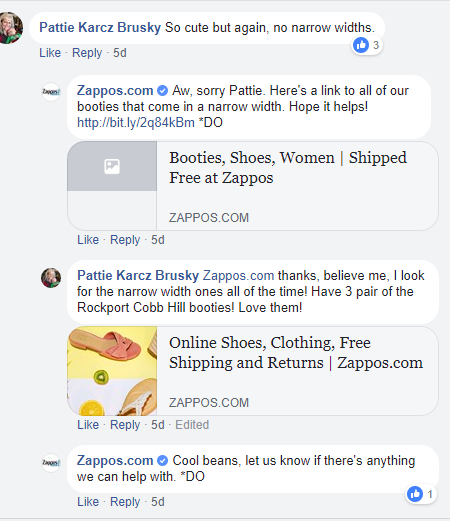
Solution: Instead of turning a blind eye, why not take advantage of such
situations to shine? How? Well, respond with a thoughtful and prompt reply to show that you are committed to highest customer satisfaction. This way, you will not only be able to calm and retain your irate customer, but also make a statement about your commitment to customer service.
Mistake 3: You Have the Wrong Objective.
Most marketers just go into their Facebook with the objective of “creating awareness” or “generating more likes for my page.” Not all brands have the luxury of big awareness budgets like brands such as Coca-Cola or Procter & Gamble. Rather than spend all your budget creating awareness, brands should note that their Facebook ads should create only one thing: a sale.
The ideal Facebook ad is one that flashes your product in front of the right person who’s ready to buy and who then immediately clicks through to your site and…makes a purchase. Unfortunately, we don’t live in an ideal world so you may have to settle for a lead. Regardless, brand ads should generate a measurable result: either cash in the bank or valuable contact information from the prospect that your sales team can then use to follow up and try to close a sale.
Facebook can be a powerful tool for customer service and engagement. But in the end, brands have to convert their spend into sales and that should be the most important objective.
Solution: When using Facebook’s Ad Manager, there are many choices available when deciding on an advertising objective. By choosing the wrong objective, your advertising efforts could lead to an unsuccessful campaign. So, brands need to be mindful of the objectives they set when creating ads.

To make it even easier, Facebook provides a guide with design recommendation and tips to help you.
As you can see, Facebook provides brands versatile tools to create ad campaigns. They’re low-cost, highly customizable, and rich with analytics. All they have to do is test them out for yourself and see what works for your brand.
Mistake 4: You Don’t Know Your Audience.
This is the secret ingredient of Facebook advertising. There are billions of people using Facebook and every brand is just trying to target that sliver of prospects who are looking to buy what they sell.
Facebook wants brands to master this task and so they have provided tools for better targeting prospects. However, there’s only so much Facebook can do, brands need to learn how to use these tools!
Understanding your audience as a brand is just as important as knowing what you want them to do. How will they use your product? What pain points do they have that you as a brand needs to solve? Even within your overall audience, different niches will have different priorities, problems, and objections.
For example, brands can advertise to “core” audiences using things like location, interests and other demographic info shared by users. Or they can target “custom” audiences by uploading a spreadsheet of their customers and prospects that they already know with the hope that they can be found on Facebook. Brands can also ask Facebook to find “lookalike” audiences who are similar to your customers and prospects.

As a brand, You have to put your target audience ahead of your strategy. Before you open your Facebook ads manager, list out a specific profile of your prospect, this will help you tailor your ads to the right audience. You have to try out a couple of Facebook-provided demographics to discover which particular one provides the largest return on investment.
Mistake 5: Posting Less Content and Inconsistently
By posting on Facebook inconsistently and inappropriately you tell your audience, “Dear customer, we are busy doing more important things, therefore, we have no time to be human and keep you updated about us”. Organic page reach on Facebook is declining. Now more than ever, engagement should be a priority.
Solution: Create an editorial calendar for Facebook, and focus on inspiring your audience. A perfect example of a brand succeeding at this would be SaaS Company Post Planner. Their Facebook updates are consistent and their content is great. Hence, engagement is off the roof.
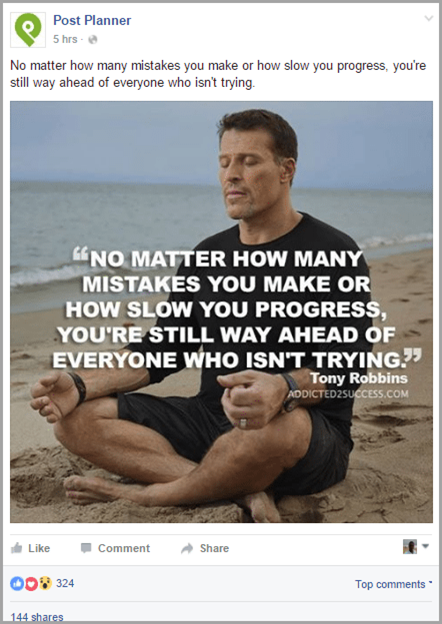
Mistake 6: Always Begging For Engagement Or Likes
Most brands publish content that screams, “We need likes!” or they ask users to like the post and bleh bleh bleh in Dracula’s voice (like-bait post).
Well, the bitter truth is Facebook will actually bury such a post. Don’t post visuals or updates asking fans to like or comment, as this tells the world how desperate your brand is and your lack of a social media strategy.
Facebook users like myself visit to share photos, watch funny ferret or cat videos, and catch up on the latest happenings in my circle; what do you think I would do seeing a brand asking for likes? I either skip the content or come pour out my heart in your comments (you don’t want the latter).
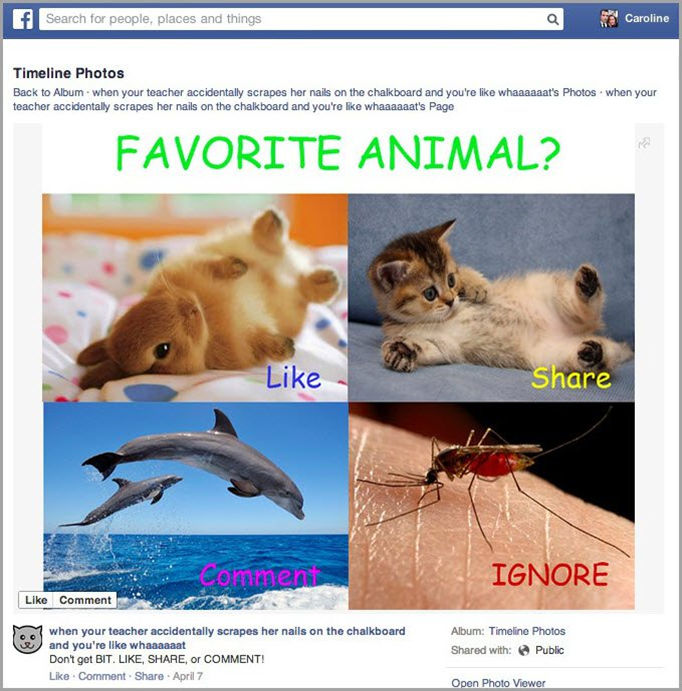
Solution: Provide a lot of helpful content regularly, and put up “real questions” that spark engagement.
Mistake 7: Not Paying To Play
Truth be told, brands can’t market or fully reach individual Facebook audiences without paying. So to get more eyes on your content, you must be willing to pay Facebook.
You don’t publish and pray and expect it to rain likes and comments; with great content you should get a healthy organic reach but want a larger reach? Pay to play.
Solution: Facebook admitted it several times that organic page reach is decreasing. However, using the “boost post” feature would instantly get more eyes and engagement on your brand and content.
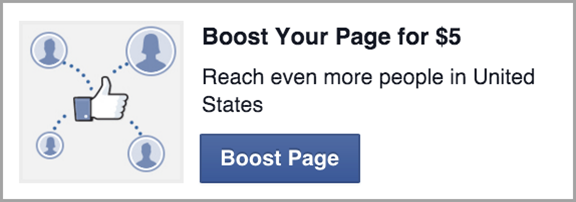
Mistake 8: Ignoring The Fact That The World Is Mobile
Facebook statistics as at March 2016 have shown that there are over 1.65 billion monthly active Facebook users, and a whopping 1.51 billion of these are mobile users or visitors.
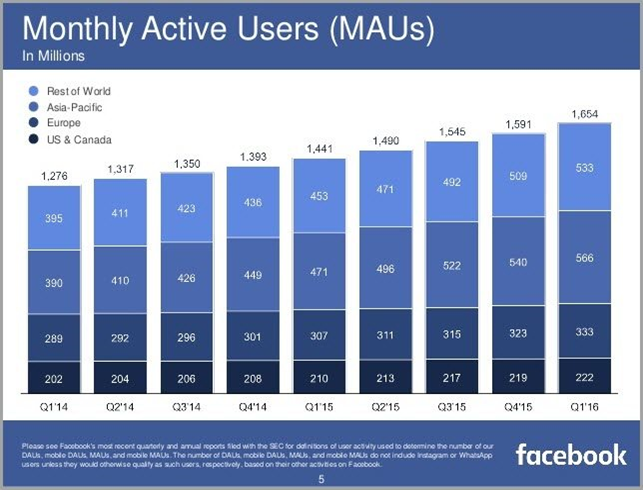
These numbers are too huge to ignore. Brands should optimize their Facebook pages for mobile users; having cropped out visuals or missing page components damages the user experience.
Take, for example, the visuals below: the visual on Coca-Cola’s cover was optimized for desktops only, making mobile visitors to the page believe Coca-Cola has some spiritual agenda.
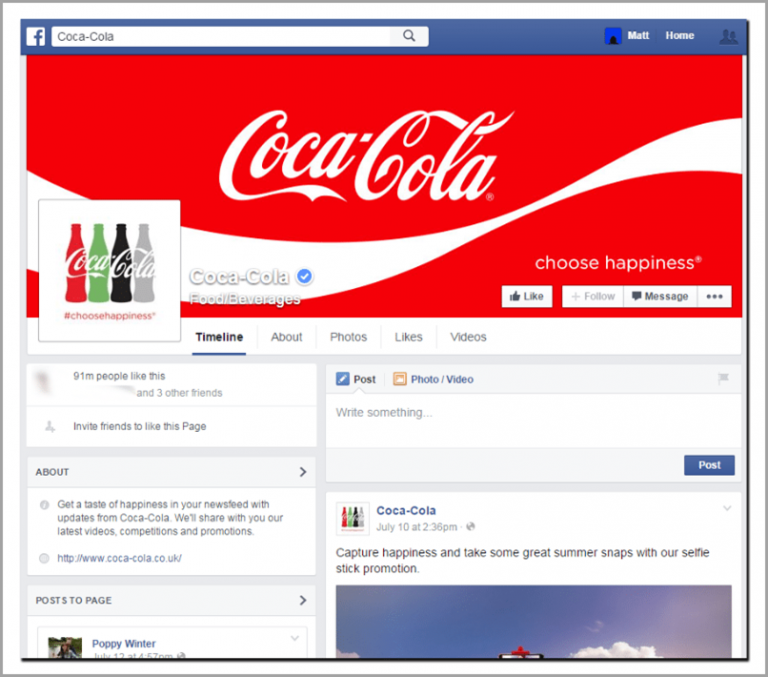
Now take a look at the mobile version of the same cover

Choosing what now Coca-Cola? Have they gone spiritual?
Mistake 9: Publishing The Wrong Type Of Content
You don’t plant a potato and harvest marshmallows. The same applies to content and engagement on Facebook; using irrelevant hashtags or twisting up trends can be a bad blow for business.
For example, the visual below:
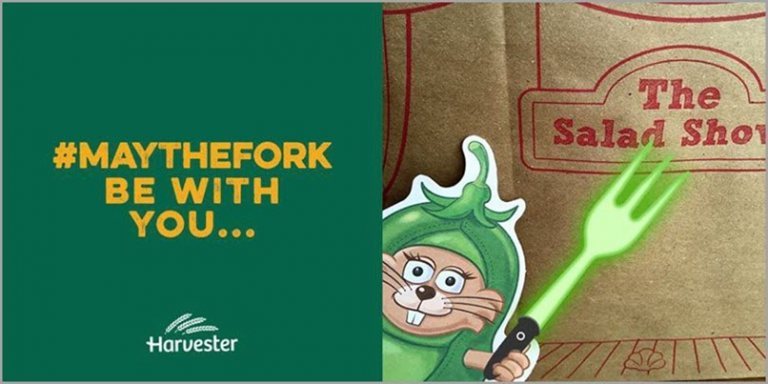
Having made up Star Wars day isn’t enough, brands have to make it even more contrived and use an absurd hashtag.
Want to grow a following on Facebook or increase engagement? Posting inappropriate comments and pictures, using click bait, being all about traffic and sales would not work!
Damn, you are so greedy and we can see it! However, Facebook is cracking down on click-bait posts and will continually drown them in the newsfeed; be original and creative.

Solution: Publishing behind-the-scenes pictures of employees, pictures of products, videos or pictures of a typical day at the company or events, holidays and birthdays will increase brand perception, engagement, and page likes.
Brands should not rely on Facebook marketing to make sales. The truth is everyone hates being sold.
Mistake 10: Not Engaging Customers In Comments
Another deadly sin brands make includes not engaging fans in comments. Being social involves you interacting with fans, asking questions and responding.
Brands should be involved in the conversation in their Facebook comments, responding to feedback, lending a helping hand or increasing engagement creatively.
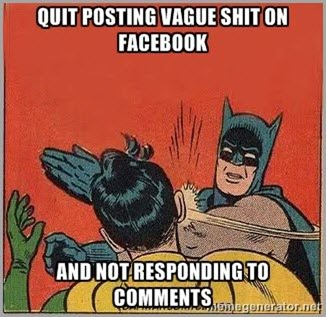
Solution: Engage fans in your comments, address feedback and spread the brand image.
Mistake 11: Trying To Sell Every Time
Too much of selling beats the purpose of being social. Brands should abstain from selling and focus more on user experience, building a community and providing value. That way, users remain loyal and increase their spending potential to your brand through the law of reciprocity.
Solution: Facebook is rolling out the shop store for Facebook pages, simply add your products into your shop and users can buy once they visit your page.

Mistake 12: Ignoring Or Deleting Negative Feedback or Comments
Handling trolls and negative feedback requires a dedicated Facebook team, patience and creativity. Brands are expected to respond to trolls and negative comments in a respectful and playful tone to keep the community mood light and friendly or it might result in disastrous PR for that brand.

Solution: Tara Hornor wrote an epic post with tips on handling Trolls and negative comments.
Mistake 13: Ignoring Advanced Facebook Advertising
Advertising on Facebook does not end with clicking “Boost Post”. For instance, you could create a lookalike audience based on subscribers already on your mailing list, who are on Facebook, and send targeted ads to them.
The true potential of Facebook advertising cannot be quantified; brands should take specific steps in creating ads that offer great incentives while achieving business goals.
Solution: Use Facebook’s Power Editor to create ads to gain leads and advertise new products, but don’t spam your users’ newsfeed.

Mistake 14: Refusing To Evolve Like Facebook’s Algorithm
Facebook changes its algorithm randomly; the latest changes in the Facebook algorithm include bringing content to users based on previous interaction.
Brands are expected to keep up with the latest updates to ensure a consistent user experience in regards to content, cover photos, and ads.
Solution: Brands should bookmark (literally) the Facebook for pages web page to stay updated with the latest algorithm updates and implement to increase engagement and brand perception.
Sum up
Facebook marketing requires creativity, A/B testing, and constantly staying ahead of the latest changes from Facebook. For a brand to successfully reach, inspire and engage its audience, the above solutions are required.
Guest Author: Pius Boachie is a freelance writer and social media strategist who offers ghostwriting, copywriting and blogging services. He works closely with B2C and B2B businesses providing digital marketing content that gains social media attention and increases their search engine visibility. On his blog DigitiMatic, he shares actionable marketing and branding advice for businesses.